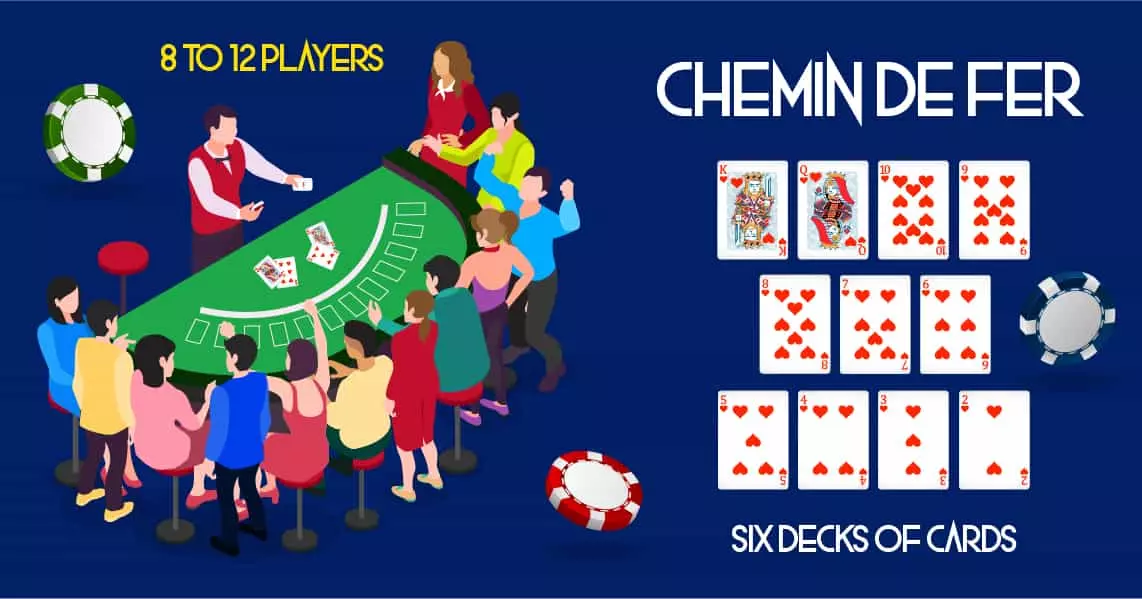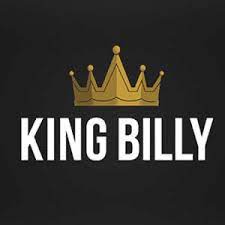Chemin de Fer Baccarat
Chemin de Fer, a variant of real money Baccarat, has long fascinated players worldwide with its unique blend of strategy and chance. This article aims to provide a thorough understanding of the game, catering to both novices and seasoned professionals. From its historical roots to advanced strategies, you will find an in-depth analysis of every facet of Chemin de Fer.
Best Chemin de Fer Baccarat Casinos
Welcome Bonus €/$2500 + 250 Free Spins
Welcome Bonus up to €/$300 + 200 Free Spins
Welcome Bonus up to €/$300 + 22 Free Spins
Welcome Bonus up to €100 + 100 Free Spins
Introduction to Chemin de Fer
Chemin de Fer, often referred to simply as Chemin, is a popular card game that holds a storied place in gambling history. Distinguished by its engaging gameplay, it has been a staple in casinos and private gaming rooms for centuries. This section delves into the basic premise of the game, offering a foundational understanding for newcomers.
Unlike other casino games, Chemin de Fer involves a rotating banker, adding a unique dynamic to the gameplay. It is typically played with six decks of cards, and the objective is to have a hand with a point total closest to nine. Understanding these fundamental aspects is crucial for anyone looking to delve into the world of Chemin de Fer.
Key Point: The rotating banker and the goal of achieving a point total closest to nine are central to Chemin de Fer.

Origins and Cultural Significance
The origins of Chemin de Fer date back several centuries, with roots in France and Italy. Initially played by the aristocracy, it quickly gained popularity across Europe. This section explores the historical background of Chemin de Fer, providing context for its current status in the gambling world.
Cultural references to Chemin de Fer in literature and film have played a significant role in its mystique and allure. Notably, it has been featured in various James Bond movies, further cementing its reputation as a game of sophistication and glamour. This cultural impact underlines the game’s enduring appeal.
Distinguishing Chemin de Fer from Other Baccarat Variants
While sharing similarities with other Baccarat games, Chemin de Fer has distinct features that set it apart. This section outlines these differences, providing clarity on what makes Chemin de Fer unique. Understanding these distinctions is essential for players transitioning from other Baccarat variants.
Among the key differences is the role of the banker. In Chemin de Fer, the banker position rotates among the players, unlike in other variants where the casino permanently holds this position. This leads to a more interactive and dynamic game experience.
| Feature | Chemin de Fer | Other Baccarat Variants |
|---|---|---|
| Banker Role | Rotates among players | Held by the casino |
| Number of Decks | 6 decks | Varies, often 8 decks |
| Player Interaction | High | Low to moderate |
| Game Pace | Slower, more strategic | Faster, more straightforward |
The Rules of Chemin de Fer
Understanding the rules is essential for mastering Chemin de Fer. This section breaks down the game’s rules into easily digestible information, ensuring that both beginners and seasoned players can grasp the essentials of gameplay. A comprehensive knowledge of these rules forms the foundation for effective strategy development.
The game begins with players deciding who will be the first banker. Bets are then placed against the banker’s stake. The unique aspect of Chemin de Fer is that players, not the house, bank the game, which significantly influences the game’s dynamics and strategies.
Key Point: The players’ role in banking the game is a distinctive feature of Chemin de Fer that impacts the overall strategy and gameplay.
Basic Gameplay and Objectives
The primary objective in Chemin de Fer is to have a hand with a total value closest to nine. Each round begins with the banker dealing cards to themselves and the players. The fundamental gameplay involves deciding whether to draw a third card or stand with the initial two cards.
Strategic decision-making is crucial in Chemin de Fer, as players must assess their hand and anticipate the banker’s actions. This element of strategy sets it apart from more luck-based card games and adds depth to the playing experience.
- Assessing hand value
- Anticipating the banker’s moves
- Deciding to draw a third card or stand
Card Values and Scoring System
The value of cards in Chemin de Fer is straightforward but differs slightly from other card games. Understanding this scoring system is vital for effective gameplay. Aces are worth one point, numbered cards retain their face value, and face cards and tens are worth zero points.
In cases where the total exceeds nine, the second digit of the total is considered the hand’s value. This unique scoring system adds a layer of complexity and can influence a player’s decision on whether to draw another card.
| Card Type | Value in Chemin de Fer | Notes |
|---|---|---|
| Aces | 1 point | Always valued at one |
| 2 to 9 | Face value | Retain their numerical value |
| 10s, Jacks, Queens, Kings | 0 points | Often referred to as ‘baccarat’ |
Role of the Banker and Players
The banker in Chemin de Fer plays a pivotal role, setting the stakes and competing against the players. Their decisions can significantly influence the game’s outcome, making the role both challenging and rewarding. Players, on the other hand, aim to outplay the banker by forming a hand closer to nine.
Players have the option to ‘go bank’, challenging the banker with a wager up to the amount of the bank’s stake. This aspect introduces an additional strategic layer, as players must decide when to take this risk.

Playing Chemin de Fer
Playing Chemin de Fer effectively requires a blend of strategy, intuition, and understanding of the game’s flow. This section offers insights into the gameplay, focusing on the nuances that can influence the outcome. Whether you are a novice or a seasoned player, these insights can enhance your playing experience.
The game’s pace and the interaction between players and the banker create a dynamic environment. Adapting to this environment and making decisions under pressure are skills that players develop over time. This adaptability is key to success in Chemin de Fer.
Game Setup and Flow
Setting up a game of Chemin de Fer involves organizing the players, selecting a banker, and preparing the card decks. The flow of the game is marked by rounds of betting, dealing, and decision-making. Understanding this flow is essential for maintaining pace and making strategic decisions.
The initial phase involves players placing their bets, followed by the banker dealing the cards. The progression from betting to card dealing to player decisions forms the rhythm of the game, which experienced players learn to navigate skillfully.
- Organizing players and selecting a banker
- Preparing the card decks
- Progression of betting, dealing, and decision-making
Player Decisions and Strategy
Players in Chemin de Fer face critical decisions, particularly regarding when to draw a third card or stand. These decisions are influenced by the player’s current hand and their assessment of the banker’s potential actions. Developing a strategy around these decisions is a cornerstone of skilled play.
Players must also consider their betting strategies, deciding when to increase their stakes and when to play more conservatively. Balancing risk and reward is a constant challenge in Chemin de Fer.
Banker’s Strategy and Responsibilities
The role of the banker in Chemin de Fer is multifaceted, encompassing both game management and strategic play. As a banker, managing the bank’s stake and making decisions on card drawing are critical responsibilities. A successful banker must balance risk management with the pursuit of winning strategies.
Bankers must also be adept at reading players’ actions and strategies, as this can influence their own decisions. The ability to anticipate player moves and adapt accordingly is a mark of a skilled banker.
- Managing the bank’s stake
- Decision-making on card drawing
- Reading players’ actions and adapting strategies
Advanced Strategies in Chemin de Fer
To excel in Chemin de Fer, players must go beyond basic rules and delve into advanced strategies. This section aims to equip players with sophisticated tactics, enhancing their ability to make calculated decisions and improve their winning chances. These strategies are crucial for players looking to elevate their game to a professional level.
Understanding the subtleties of betting, card handling, and psychological aspects of the game can significantly impact performance. Advanced players often employ a mix of analytical skills and intuition to gain an edge over their opponents.
Winning Tactics for Players
Developing winning tactics as a player in Chemin de Fer involves a deep understanding of odds and probabilities. Knowledge of when to draw a card or stand, based on the banker’s actions and visible cards, can drastically alter the game’s outcome.
Effective bankroll management is another key aspect of advanced play. Players must learn to adjust their bets based on the state of the game and their own financial limits, ensuring a sustainable approach to the game.
- Understanding odds and probabilities
- Card drawing decisions based on game state
- Effective bankroll management
Insights for Aspiring Bankers
For those aspiring to be successful bankers in Chemin de Fer, there are specific insights and strategies to consider. Bankers must be adept at managing their stakes, making calculated decisions on when to accept bets, and understanding the risk associated with each decision.
A keen sense of observation is crucial for a banker, as it allows them to read players’ tendencies and predict their next moves. This foresight can be pivotal in deciding whether to draw an additional card or stand.
Understanding the Odds and House Edge
A thorough understanding of the odds and the house edge is vital for any serious Chemin de Fer player. This knowledge helps in making informed decisions and strategizing effectively, both as a player and a banker.
The house edge in Chemin de Fer can vary based on the rules and the skill of the players. Recognizing these variations and adapting one’s play accordingly is a mark of an advanced player.
| Aspect | Impact on Game | Player Consideration |
|---|---|---|
| Odds of Winning | Influences betting decisions | Adjusting strategy based on probability |
| House Edge | Affects long-term profitability | Adapting to rule variations |
| Player Skill Level | Varies game dynamics | Adjusting play based on opponents |
Chemin de Fer Etiquette
Etiquette plays a significant role in Chemin de Fer, contributing to the game’s sophisticated and respectful atmosphere. This section highlights the importance of etiquette, providing guidelines for player conduct. Adhering to these principles not only enhances the gaming experience but also reflects respect for fellow players and the tradition of the game.
From table manners to interaction with the dealer and other players, understanding and observing proper etiquette is key. This respect for the game’s customs and courtesies is a hallmark of a seasoned Chemin de Fer player.
Table Manners and Protocols
Table manners in Chemin de Fer encompass everything from handling cards and chips to the way players place their bets. Proper conduct at the table is not just about following rules; it’s about demonstrating sophistication and respect for the game’s integrity.
Players are expected to maintain a level of decorum, avoiding overly emotional reactions to wins or losses. This composure is a sign of professionalism and respect for the game and fellow players.
Interaction with Players and Bankers
Interactions with other players and the banker are an integral part of Chemin de Fer. Communicating with courtesy and respect, regardless of the game’s outcome, is paramount. This section outlines the norms for player and banker interactions, emphasizing the importance of sportsmanship.
Players should also be mindful of the pace of the game, ensuring their actions do not unnecessarily delay play. Timely decision-making and adherence to the flow of the game contribute to a smooth and enjoyable experience for all participants.
- Communicating with courtesy and respect
- Maintaining sportsmanship regardless of outcomes
- Ensuring timely decision-making and game flow
Summary and Final Thoughts on Chemin de Fer
This article has explored the various aspects of Chemin de Fer, from its rich history to advanced strategies. We’ve covered the rules, gameplay, etiquette, and strategic considerations, providing a comprehensive guide for players at all levels. As we conclude, let’s summarize the key points and offer final thoughts on this classic game.
Chemin de Fer stands out for its unique blend of skill, strategy, and social interaction. Its distinguished history and cultural significance add to its allure, making it more than just a card game, but a tradition rich in sophistication and elegance.
Comparative Analysis
When compared to other card games, Chemin de Fer offers a unique experience. Its player-banked nature and strategic depth provide a distinct gameplay experience that is both challenging and rewarding.
| Game Aspect | Chemin de Fer | Other Card Games |
|---|---|---|
| Banking | Player-banked | House-banked |
| Strategic Depth | High | Varies |
| Social Interaction | Integral part of gameplay | Less emphasized |
| Cultural Significance | Rich historical background | Varies |
Frequently Asked Questions (FAQ) about Chemin de Fer
In this final section, we address some common questions about Chemin de Fer. This FAQ aims to clarify any remaining uncertainties and provide additional insights into the game.
What is the primary objective in Chemin de Fer?
The primary objective is to have a hand with a total value closest to nine. Players must decide whether to draw a third card or stand based on their hand and the banker’s potential actions.
How does Chemin de Fer differ from other Baccarat variants?
Chemin de Fer is distinguished by its rotating banker role and player-banked nature. This leads to a more interactive and dynamic game experience compared to other Baccarat variants where the casino permanently holds the banker position.
What are some key strategies for winning in Chemin de Fer?
Key strategies include understanding odds and probabilities, making informed decisions on when to draw a card or stand, and effective bankroll management. Additionally, observing and adapting to the banker’s and other players’ actions can be advantageous.



